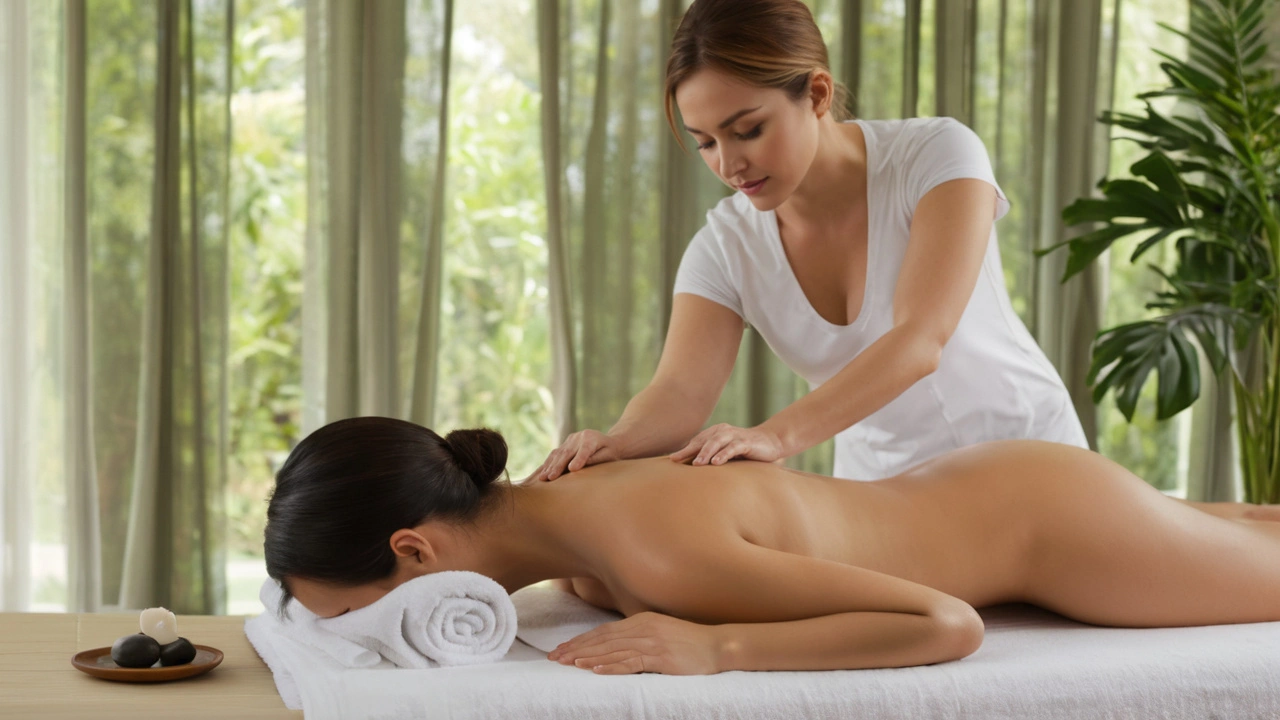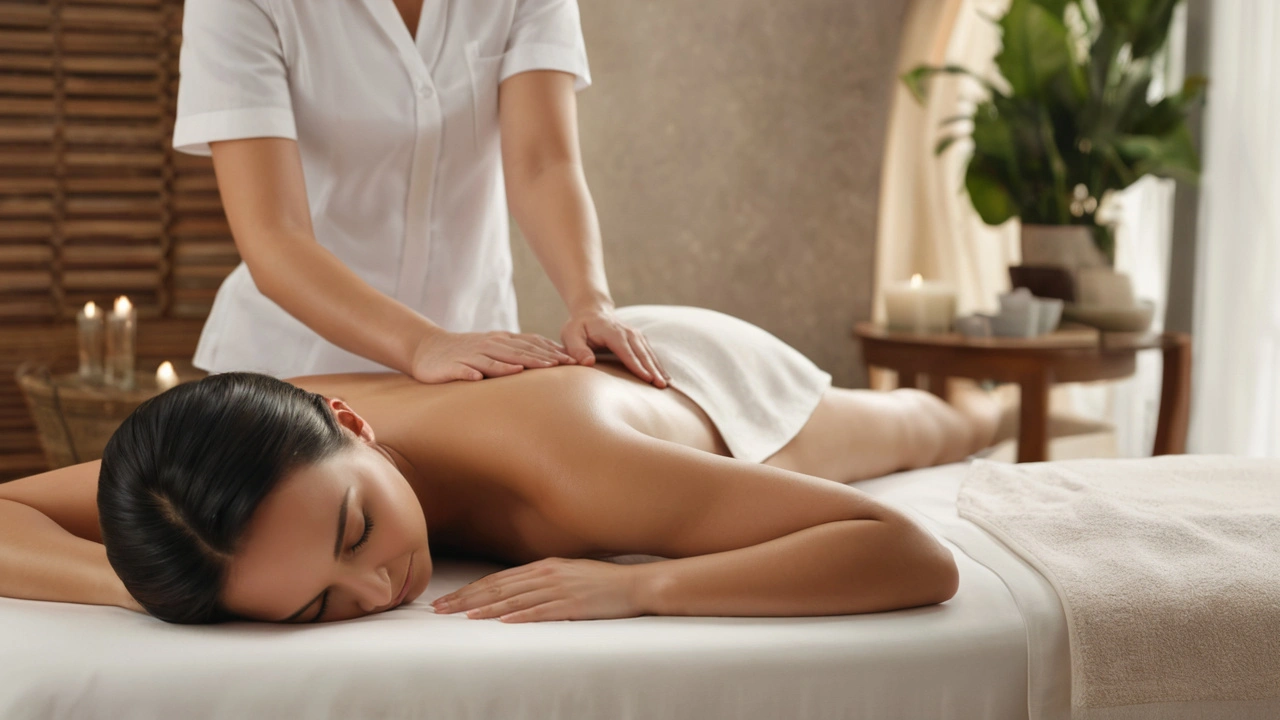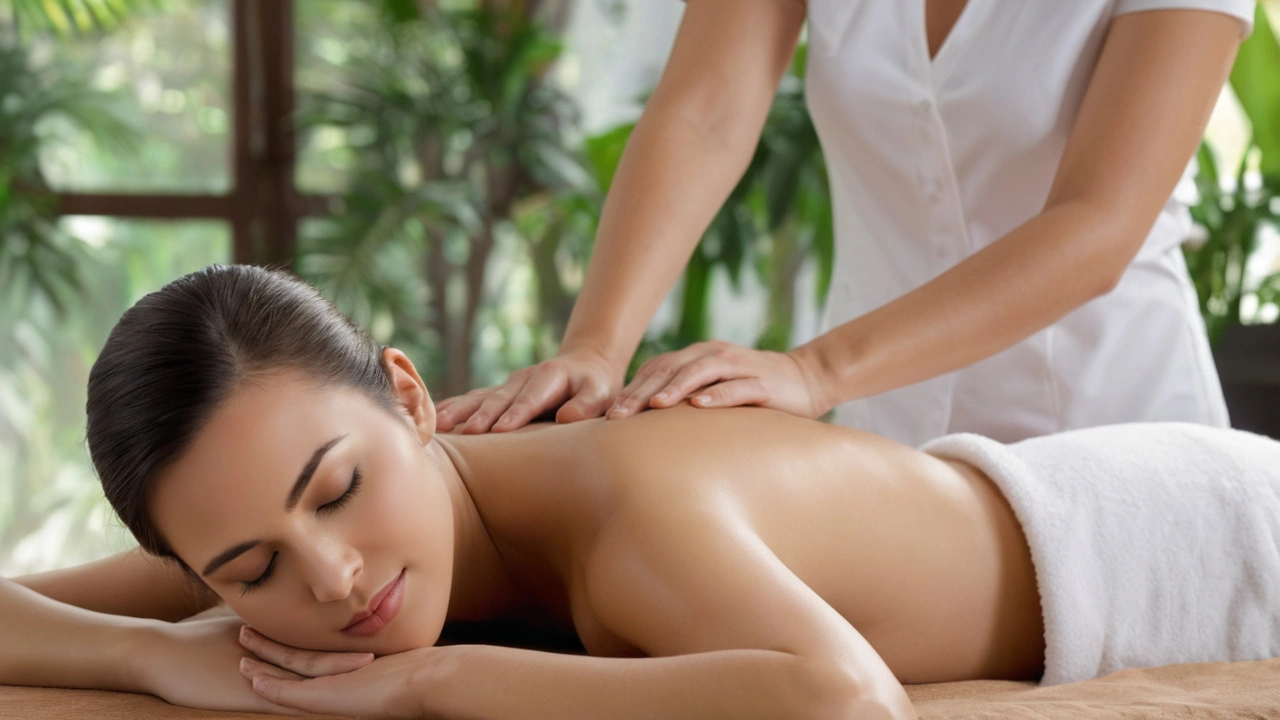Blind Massage: Embracing Healing Through the Power of Touch
 Aug, 1 2024
Aug, 1 2024
Blind massage is more than just a treatment; it's a dance of trust and connection between massage therapist and client. Rooted in traditional practices, this unique form of therapy has been touching lives, literally and figuratively, for centuries.
The concept is simple yet profound: without the sense of sight, blind massage therapists develop an enhanced sensitivity to the client's body, leading to a more intuitive and effective healing touch. This heightened sense of touch allows for a massage experience that can be deeply mindful and therapeutic.
For many, the benefits are not merely physical but extend into realms of emotional and psychological relief, making blind massage a holistic approach to wellness. Stories from both practitioners and clients underscore the transformative power of this practice. Whether you're seeking relief from chronic pain, stress reduction, or simply an opportunity to unwind, a blind massage session might just be the answer.
Origins and Evolution
The history of blind massage is as rich and textured as the practice itself. It traces its roots back to ancient civilizations where touch and healing were closely intertwined. One of the earliest and most well-documented traditions comes from ancient China, where blind massage therapists were respected and highly sought after for their unparalleled skills.
In traditional Chinese medicine, it was believed that individuals who were blind developed a superior sense of touch that could detect imbalances and blockages in the body's energy pathways, or meridians. This heightened sensitivity allowed blind therapists to provide treatments that were considered more intuitive and effective. As a result, many visually impaired individuals were trained in the art of Tuina, a form of Chinese manipulative therapy often used alongside acupuncture and herbal treatments.
During the Tang Dynasty (618-907 AD), blind massage became even more institutionalized. Historical records indicate that it was common for visually impaired individuals to be employed in royal courts and elite circles. Their reputation for delivering exceptional massage therapy persisted through subsequent dynasties, contributing to the formalization of massage schools and certification programs dedicated to training blind therapists.
"Without vision, they rely on a deep sense of touch that can perceive even the subtlest tensions in the body," says Dr. Ming Yeung, a historian of traditional Chinese medicine. "This makes their treatments extraordinarily personalized."
As the practice spread beyond China, blind massage found its place in other cultures around the world. In Japan, for instance, it became known as Anma and later influenced the development of Shiatsu. The Japanese government officially recognized blind massage as a profession, which provided job opportunities and helped integrate visually impaired individuals into society. In many ways, this also preserved the art and ensured its transmission through generations.
In modern times, the evolution of blind massage continues as it intersects with contemporary therapeutic practices. Schools and training centers around the globe now offer specialized programs to teach the necessary skills to both blind and sighted individuals. These programs often include not just traditional techniques but also an understanding of human anatomy, physiology, and modern wellness trends. With growing awareness of diverse therapeutic approaches, blind massage has earned a place in spas, wellness centers, and even clinical settings, where its benefits are recognized and celebrated.
The evolution of blind massage highlights not just a fascinating historical journey, but also a testament to overcoming limitations and turning them into strengths. It's a beautiful reminder that true skill and empathy extend beyond the senses, providing a powerful healing touch that resonates with many.
Key Benefits
Blind massage offers a multitude of benefits that go beyond mere relaxation. One of the most notable advantages is the heightened sensory perception of blind massage therapists. Without relying on sight, these therapists often develop a more acute sense of touch, which allows them to detect and address nuances in muscle tension and stress points that might go unnoticed by sighted practitioners. This heightened tactile awareness can lead to more effective therapeutic outcomes for the client.
Another significant benefit is the emotional and psychological impact. For instance, the non-visual connection created during a blind massage session can help clients feel a deeper sense of trust and safety. This can be particularly beneficial for individuals dealing with anxiety or trauma, as the therapy provides a calming environment where they can feel cared for and understood. Studies have shown that therapeutic touch can lower cortisol levels and increase serotonin and dopamine, which are chemicals in the brain associated with happiness and well-being.
Moreover, blind massage can enhance the overall sensory experience. The absence of sight can make clients more attuned to the therapist's touch, amplifying the sensations and thus the effectiveness of the massage. This can result in a more immersive and satisfying experience. According to a survey conducted by the American Massage Therapy Association, over 70% of clients reported experiencing higher satisfaction levels with blind massages compared to conventional massages.
Physical health benefits are also plentiful. Regular sessions can help alleviate chronic pain, improve circulation, and reduce muscle stiffness. These benefits are particularly valuable for individuals suffering from conditions such as arthritis, fibromyalgia, or chronic back pain. Enhanced circulation resulting from massage can also contribute to better skin tone and overall vitality.
Let's not overlook the empowerment aspect for the therapists themselves. Engaging in this profession not only provides financial independence but also boosts self-esteem and social inclusion. Many blind therapists report feeling a profound sense of purpose and fulfillment in their work. As one blind massage therapist aptly put it,
"The power of touch transcends the need for sight; it allows me to connect deeply with my clients and offer a unique form of healing that goes beyond the physical."
In recent years, several studies have helped quantify these benefits. For instance, research published in the Journal of Bodywork and Movement Therapies highlighted that clients who received blind massage reported a 30% higher rate of pain relief and stress reduction compared to those who received standard massage therapy. Such data underscores the efficacy and added value of this unique practice.

Techniques and Training
Blind massage therapists often follow a path of training that is both comprehensive and specialized. The journey to becoming a competent practitioner begins with rigorous education. Usually, this starts at a specialized school or institute where the focus is on developing an acute sense of touch and an in-depth understanding of human anatomy. Blind therapists typically spend hundreds of hours in hands-on training, learning various massage techniques like Swedish, deep tissue, and shiatsu, to name a few.
One crucial aspect of their training is the emphasis on tactile sensitivity. Without the use of sight, blind therapists rely heavily on their sense of touch to navigate a client's body. This reliance often leads to a heightened sensitivity, allowing them to detect muscle knots, tension, and other issues more acutely. A study from the University of Applied Sciences in Hamburg showed that blind massage therapists could identify problem areas with a success rate of 85%, which is impressively high compared to their sighted counterparts.
In addition to mastering the various techniques, blind massage therapists are trained to build a strong rapport with their clients. Effective communication is key in any therapeutic setting, and this is especially true in blind massage. Therapists learn to ask detailed questions about their clients' needs and preferences, ensuring a customized and effective treatment plan. They also often receive training in alternative therapies like aromatherapy and reflexology to complement their massage skills.
"The absence of sight allows for an unparalleled level of focus on touch. This can lead to a more intuitive and effective massage experience." — Dr. Sarah Thompson, Massage Therapy Expert
Moreover, technology plays a role in modern training programs. Advanced tools and software can simulate various scenarios, helping blind therapists practice and refine their skills. For instance, some institutions use tactile diagrams and models to teach anatomy more effectively. These tools provide a 3D representation of the human body, allowing therapists to gain a thorough understanding of muscle groups, bones, and pressure points.
Many blind massage therapists also attend workshops and continuing education courses to stay updated on the latest developments in massage therapy. These educational opportunities not only enhance their skills but also offer a platform to share experiences and learn from peers. Networking with other professionals helps them stay motivated and continually improve their practice.
Specialized training doesn't stop at physical techniques; it extends to understanding the psychological aspects of touch therapy as well. Programs often include modules on stress management, emotional intelligence, and client psychology, making the therapist well-rounded and better equipped to handle a variety of client needs.
The training process may be demanding, but the rewards are equally significant. Clients often report an exceptionally high level of satisfaction, citing the unique abilities of blind therapists to identify and address their concerns effectively. The training not only shapes skilled therapists but also contributes to their personal growth, making them more empathetic and attuned to the human condition.
Personal Stories
Personal stories bring the essence of blind massage to life, weaving a tapestry of experiences from both practitioners and clients. One such narrative comes from Emma, a massage therapist who lost her sight due to a genetic condition in her early twenties. What could have been a devastating loss turned into a remarkable journey. Emma's other senses heightened, especially her sense of touch, enabling her to connect deeper with her clients. Her intuitive understanding of their needs has led to numerous testimonials of healing and relief from chronic pain.
Tim, a long-time client, shares his experience:
"Emma's touch is unlike any other massage therapist I’ve encountered. Her fingers seem to find every knot, every point of tension, without me saying a word. It's as if she can 'see' more clearly with her hands than any sighted therapist."Tim's story is not unique, as many clients report similar experiences of feeling deeply understood and cared for, creating a space for both physical and emotional healing.
Another heartwarming story comes from Mikael, who found his calling in blind massage after an accident left him visually impaired. Trained at a renowned institute for the blind, Mikael learned various techniques that rely on heightened touch sensitivity. He discovered that his ability to 'feel' his clients' bodies allowed him to provide highly effective massages. Mikael's journey emphasizes the incredible resilience and adaptability of individuals who embrace their sensory changes to find new purpose and meaning.
Jane, a regular client of blind massage, attests to its transformative power:
"Mikael’s sessions are a sanctuary for me. His touch, imbued with so much care and precision, helps melt away my stress and anxiety. Blind massage isn't just about physical relief; it’s a holistic experience that heals mind and body."
In Japan, where blind massage has been an established profession for centuries, these personal stories are even more common. The practice, known as Anma, relies on acupressure and has been a trusted healing method for generations. The Japanese government has long supported blind massage therapists, recognizing the unique contributions they make to the wellness industry.
Emma, Tim, Mikael, and Jane’s stories are part of a larger narrative that underscores the universal effectiveness of blind massage. Through their experiences, we see how blind massage is not merely an alternative therapy but a cherished practice rooted in compassion, skill, and an extraordinary sense of touch. By sharing these personal stories, we honor the practitioners and celebrate a form of massage that goes beyond traditional boundaries to heal and connect on a profoundly human level.

Tips and Considerations
When considering a blind massage, there are several factors to keep in mind to ensure that both you and your therapist have a positive and beneficial experience. First, it's important to seek out licensed professionals. Blind massage therapists often go through rigorous training programs specifically designed to enhance their innate abilities in touch and sensation.
Start by researching and reading reviews. Word of mouth and online testimonials can be incredibly valuable in finding a therapist that suits your needs. It's also essential to have open communication. Before your session begins, speak with your therapist about any concerns or specific areas that need attention. This helps the therapist tailor the massage to your unique requirements.
Creating a comfortable environment is key. Whether in a spa setting or the comfort of your own home, ensure that the space is serene and free from distractions. This allows for a more immersive and relaxing experience. Bringing your own music or aromatherapy can also enhance the session.
Be prepared to set aside enough time. A good massage session is not something to rush. Schedule your appointment at a time when you won't feel pressured to hurry off to the next obligation. This allows you to fully unwind and absorb the benefits of the therapy. It's also worth noting that regular sessions can lead to better long-term results, so consider setting up a regular schedule if possible.
Understanding the benefits of the therapy can also enhance your experience. Blind massage therapists often have an extraordinary ability to detect muscle tension and imbalance. This means the therapy can be particularly effective for chronic pain and stress relief. According to a study by the American Massage Therapy Association, clients who receive regular massages report a significant reduction in physical pain and an increase in overall well-being.
“The power of touch is undeniable. For blind massage therapists, the heightened sense of touch transforms a simple massage into a profound therapeutic experience,” says Dr. Jane Fielding, a noted physiotherapist and author on therapeutic practices.Don’t forget to be mindful of your comfort levels. If something doesn’t feel right during the massage, communicate this to your therapist immediately. Their goal is your comfort and healing, and they can make adjustments as needed. After the massage, take some time to relax and hydrate. Massage therapy can release toxins from muscles, so drinking water helps to flush these out of your system. Resting for a while after the session enhances the benefits and allows your body to fully integrate the effects of the massage.
If you have any medical conditions or concerns, consult with your healthcare provider before booking a session. While massage therapy is generally safe, certain conditions might require special considerations or modifications to the treatment. Keeping these tips in mind can ensure that your blind massage experience is both enjoyable and beneficial. By approaching it with the right mindset and preparation, you can maximize the therapeutic potential of this unique healing art.
